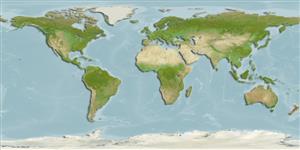Actinopterygii (ray-finned fishes) >
Gobiesociformes (Clingfishes) >
Gobiesocidae (Clingfishes and singleslits) > Gobiesocinae
Etymology: Gastroscyphus: Greek, gaster = stomach + Greek, kyphos = curved, bent (Ref. 45335); hectoris: Named after Sir James Hector, natural historian and Director of the Colonial Museum (Ref. 9003).
Environment / Climate / Range
Ecology
Marine; demersal; depth range 0 - 10 m (Ref. 9003). Temperate, preferred ?
Southwest Pacific: endemic to New Zealand.
Size / Weight / Age
Maturity: Lm ? range ? - ? cm
Max length : 6.4 cm SL male/unsexed; (Ref. 9003); max. reported age: 4 years (Ref. 9003)
Short description
Morphology | Morphometrics
Dorsal
spines
(total): 0;
Dorsal
soft rays
(total): 6-8;
Anal
spines: 0;
Anal
soft rays: 6 - 7. Color uniform or blotched reddish to olive green or brown dorsally, paler ventrally. A bar of lighter color along the head between the eyes and a narrow horizontal dark stripe from the snout to the gill cover separating the darker dorsal pigment from the paler lower surface. Occasionally a variable row of white spots along the side of the body. Distinguished from other clingfish by its distinctive body form (robust and tapers abruptly behind the dorsal and anal fins).
Commonly amongst brown algae (Cystophora) in rock pools at the low tide level and subtidal areas. Sometimes found on seaweed exposed at low tide. Swims towards cover and positions itself like drifting algae (heads up tail down position, sculling with the pectoral fins) when disturbed.
Life cycle and mating behavior
Maturity | Reproduction | Spawning | Eggs | Fecundity | Larvae
Paulin, C. and C. Roberts, 1992. The rockpool fishes of New Zealand (Te ika aaria o Aotearoa). Museum of New Zealand (Te Papa Tongarewa). 177 p. (Ref. 9003)
IUCN Red List Status (Ref. 115185)
CITES (Ref. 94142)
Not Evaluated
Threat to humans
Harmless
Human uses
More information
Age/SizeGrowthLength-weightLength-lengthLength-frequenciesMorphometricsMorphologyLarvaeLarval dynamicsRecruitmentAbundance
ReferencesAquacultureAquaculture profileStrainsGeneticsAllele frequenciesHeritabilityDiseasesProcessingMass conversion
Tools
Special reports
Download XML
Internet sources
